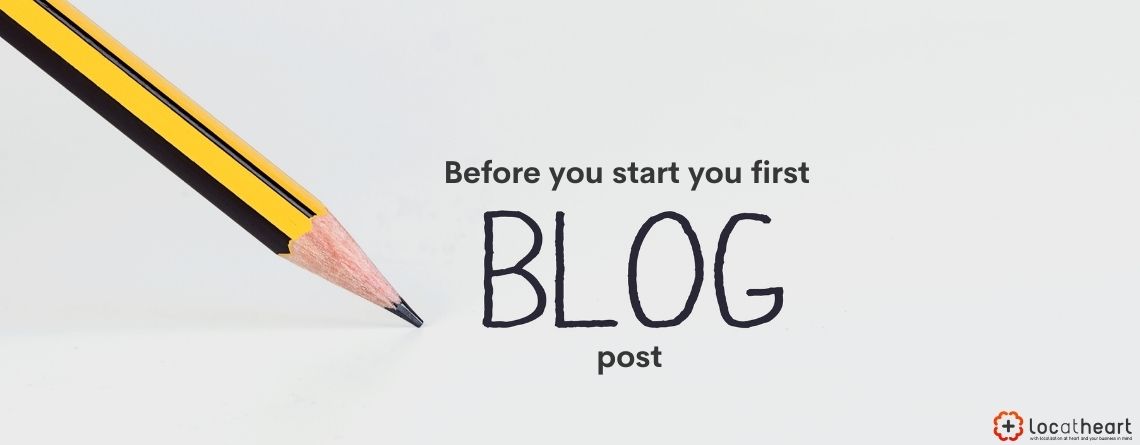7 Questions to Answer Before You Start Your Company Blog
Whether you sell services or products, a company blog can boost your SEO efforts, build professional image and trust as well as support client retention across all your markets. But blogging needs a plan of action. Before you call any copywriters make sure you answer these 7 questions and prepare a blog post brief.
The blog strategy worksheet will help you:
- prepare blog post specifications (briefs),
- set precise goals,
- select the right language for your communication,
- find relevant keywords,
- accurately reflect the message of your company.
Below, we have described each of the main steps in the worksheet to help you understand better each group of questions found in the worksheet.
At the end of this blog post you will also find a downloadable blog post brief template that you can use when you contact an agency or freelancers in all your markets. Let’s begin!
Who are you?
This is not a warm-up exercise. Whenever a piece of content is created on behalf of your brand it must reflect your identity. Think about these questions:
- What positive change does your product or service bring into the life or work of others?
- What responsibilities do you take on as a brand? Just the quality of your work? The well-being of your employees? Keeping the world as clean as possible? Believe me when I say that these answers will influence how you tackle future issues.
- Are you a master or an apprentice? Who is, or was, your teacher? Which brands are your role-models?
- Do you accept people as they are, or do you want to make them better? In other words, how educational are you? Is your offer and communication based on arousing or feeding wants and ambitions or is it focused on covering current needs? Are you relevant or cool? Or both?
These questions are here to help you define your values.
Values work best if they are relatable, actionable, and put in plain words.
If you have your values well defined, write them down.
If you find it difficult to define them, go ahead, answer the following questions and get back here when you feel ready.
What is your goal?
Sometimes a goal defines us better than our values so if you had a hard time answering the first questions, don’t worry and focus on more actionable parts of the worksheet for now.
What do you want to achieve now? In the foreseeable future?
Remember, you can change this answer whenever needed. In 6 weeks or in 6 years. The goals of your company may be temporary or incremental. Once achieved, they make space for new goals.
Goals change over time. It’s perfectly normal.
It is, however, important to write them down as you prepare your blog post brief because your content should support your goals!
What is the goal of your blog?
What is the purpose of your content? Being interesting, informative or even engaging is not a purpose. These are all just the roads we take to achieve our goals.
The purpose of content may be to:
- increase sales,
- make people realise previously unseen needs,
- educate about your product,
- encourage to order a sample or download a demo,
- build a community (or a mailing list).
Never write content just to fill some space. Every post should have a specific goal.
Remember that internet fame does not count as a business goal or purpose.
It may be a means to achieve your goals, but it is not mandatory.
Who is your audience?
Who are you writing for? Know your target demographic — should your post be directed to students at the start of their career paths, young mothers or middle-aged men with a higher education? Remember, it’s not just the number of readers but also their “quality”: the probability of them becoming your clients.
Copywriters style and customise texts according to their target group and set goals.
Remember to specify if your offer is relevant to the current needs or to the ambitions and life goals of your audience (as in the difference between a good product and a cool or prestigious product). The content and layout of the blog should reflect that.
What are your languages?
This is a 2-in-1 topic. You language can be English, Spanish or Mandarin. Also, your language can be formal, casual, joking etc. It’s not just about where your customers are but also who they are. If you are targeting Mexicans in LA, which language should you chose? Perhaps two. Or more, if your offer is relevant for a broader region.
But don’t forget about the style and tone of your language because they reflect your brand identity and let you really reach your target audience. Talk to them in the language they want (or are at least willing and able) to hear. What if you have more than one target group? You can differentiate your communication style by product line or single product but it is then very important to define some characteristics that will remain consistent across all your content.
When deciding on a blog in a foreign language, analyse how your offer fits the new market and ascertain the need for localisation (customer expectations and legal requirements). Plan for multilingual SEO.
Remember that users may use your application in English, but still expect assistance in their native language, if needed.
What are your keywords?
Use the right keywords. You’ve heard it a thousand times!
But have you ever considered how what’s “right” about keywords may differ from region to region and from country to country?
Do you like potatoes? “Potatoes” may be the most versatile word, but what if your business is developing in Ireland? Should you use “spuds” instead to sound a bit more local?
This goes further as you move across state borders. Translating keywords is not enough. You should verify each foreign keyword with at least search results, but it’s much better to use professional tools or work with a multilingual SEO partner who can research keywords for each new market.
Do not pick keywords based on their popularity only. Otherwise, you may draw in random people who may not be interested in what you are offering.
Remember that your customers may use different phrases than you do and they may not be familiar with jargon. Find keywords that are likely to actually be entered into a search bar.
What keeps your audience engaged?
Apart from the specifics of your target group, remember these general ever-greens:
- proper formatting,
- division into paragraphs,
- use of headers,
- relatable images,
- clear graphics.
It’s a good idea to adapt the layout to the audience’s language and culture, so that they can, for example, relate to people in pictures.
Remember that customers enticed by “bait” keywords will not engage. Instead, they will quickly leave your blog, thus worsening your position in search engines.
Now, create your blog post brief
Now you are ready to prepare professional blog post briefs – lists of requirements for each blog post or groups of blog posts. Use our blog post brief template or create your own, but make sure your copywriters get all the relevant information.
If you don’t feel confident in SEO, you can start with finding a keyword research expert who will use your brief to define the right keywords for your content. Find a multilingual SEO partner to identify keywords that will work well in a given language and verify topics picked for different markets.
Now you are ready to contact a copywriter, who will use your blog posts brief to create worthwhile content for your company blog.







Leave a Reply